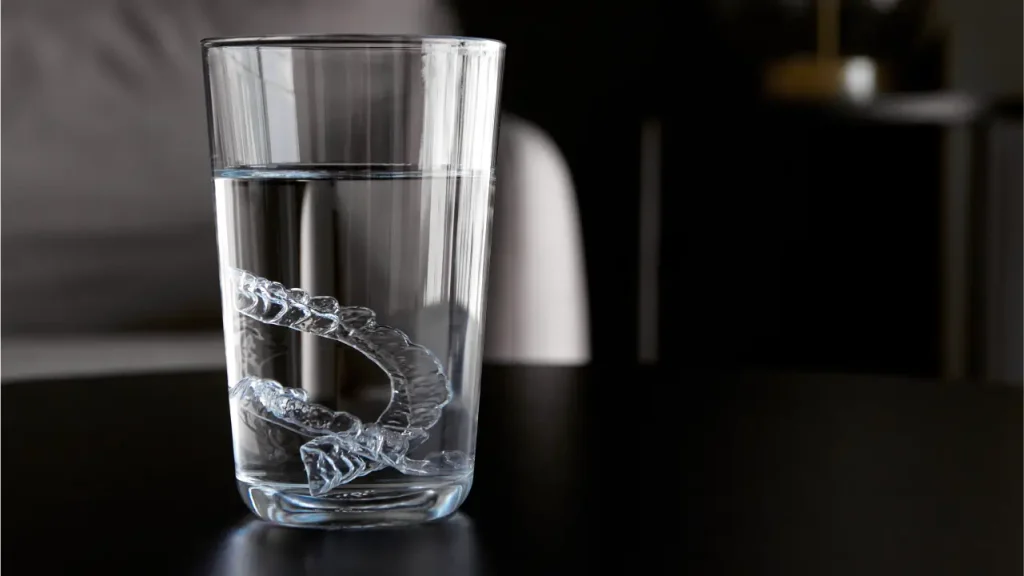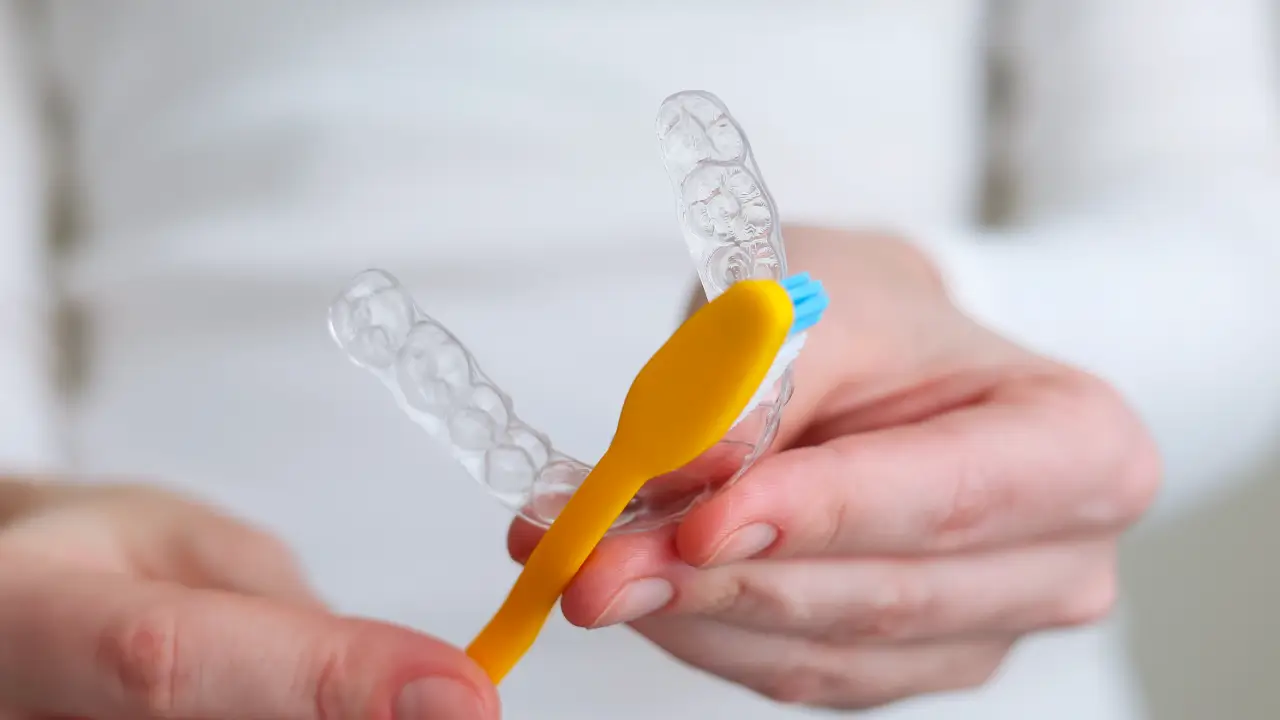Maintaining clean aligners is crucial for both your oral health and the success of your treatment. Clean aligners not only help keep your teeth healthy by preventing plaque and bacteria build-up, but they also ensure your aligners remain clear and effective throughout your treatment. Proper cleaning helps avoid discolouration, bad breath, and potential treatment setbacks.
In this article, we’ll guide you through the best practices for keeping your aligners clean and share tips on what to do and what to avoid. Let’s dive in and ensure your smile journey stays on track!
Why is cleaning my aligners important?

Keeping your aligners clean is essential for maintaining optimal oral hygiene and ensuring the effectiveness of your treatment. Here’s why it matters:
Prevents discolouration
Regular cleaning helps keep your aligners clear and free from stains. Without proper care, food particles and bacteria can lead to discoloration, which can affect how your aligners look and how confident you feel as they get less discreet.
Avoids bad breath
Bacteria build-up on dirty aligners can cause bad breath. By keeping your aligners clean, you’re not just protecting your teeth; you’re also maintaining fresh breath.
Maintains effectiveness
Clean aligners work better to straighten your teeth as planned. If they’re covered in bacteria or stains, they might not fit properly or work as effectively, which could slow down your progress.
Promotes oral health
Clean aligners help prevent plaque build-up and protect your teeth from potential issues. By maintaining good oral hygiene, you’re ensuring that your teeth stay healthy throughout your treatment.
Ways to clean your aligners

Keeping your aligners sparkling clean is easier than you might think. Here are some practical and easy-to-follow tips to ensure your aligners stay in great condition:
Rinsing your aligners regularly
One of the simplest and most effective ways to keep your aligners fresh is by rinsing them regularly. After meals or drinks, give your aligners a quick rinse under lukewarm water. This helps remove food particles and prevents any buildup. Make it a habit to do this every time you take your aligners out to keep them in tip-top shape!
Brush gently
Gentle brushing is key to keeping your aligners clean without causing damage. Use a soft-bristled toothbrush and a mild, non-abrasive soap or a dedicated aligner cleaner. Avoid using toothpaste, as it can be too harsh and may scratch the aligners.
A quick, gentle brush twice a day, along with your regular brushing routine, will help keep your aligners clear and fresh.
Aligner cleaning tablets
For a deeper clean, aligner cleaning tablets are a fantastic option. Simply drop a tablet into a glass of lukewarm water, then place your aligners in the solution. Let them soak for the recommended time (usually around 3 minutes). The cleaning solution will help remove any lingering bacteria and stains. It’s a quick and effective way to keep your aligners looking like new!
Frequency of cleaning
Aim to rinse your aligners each time you remove them, especially after eating or drinking. Brush them gently at least twice a day, ideally in the morning and before bed. Use cleaning tablets every few days for a thorough cleanse, or as recommended by your dentist.
Alternative cleaning solutions
If you don’t have aligner cleaning tablets on hand, a mild, non-alcoholic mouthwash can be a good alternative for a quick clean. Just make sure it’s not too harsh and doesn’t contain dyes or alcohol that could affect your aligners.
How to handle stains
If you notice any stains or discoloration on your aligners, a soak in cleaning tablets or a mix of water and baking soda can help. Gently scrub with a soft brush and rinse thoroughly. For persistent stains, consult your dentist for advice.
Maintaining the aligner case
Don’t forget to clean your aligner case regularly too! Wash it with warm water and mild soap, and let it dry completely before placing your aligners back in. A clean case helps prevent bacteria buildup and keeps your aligners safe.
Travel-friendly tips
When you’re on the go, carry a small travel-sized aligner cleaning kit with you. Many kits come with compact cleaning tablets and a portable case, making it easy to keep up with your cleaning routine no matter where you are.
Do’s and Don’t when cleaning your aligners
To help you navigate the do’s and don’ts of aligner maintenance, we’ve put together a list of best practices and common pitfalls to avoid. Following these tips can help keep your aligners clean, comfortable, and effective, ensuring you get the most out of your smile journey.
Do’s for cleaning aligners
- Brush after eating
Give your aligners a quick rinse or brush after meals. This helps prevent food particles and plaque from settling, keeping your aligners fresh and clear.
- Remove your aligners when eating
Always take out your aligners before meals. This not only helps avoid damage but also prevents food from getting stuck in them, which can lead to stains and bacteria build-up.
- Avoid sugary, colored, and acidic drinks
Steer clear of sugary, colored, and acidic beverages while wearing your aligners. These drinks can stain and affect the material of your aligners, as well as increase the risk of cavities.
- Regularly brush and floss your teeth
Keeping your teeth clean is just as important as cleaning your aligners. Brush and floss daily to remove plaque and food particles, ensuring your aligners work effectively and your oral health stays on track.
Don’ts for cleaning aligners
- Don’t use hot water
Avoid cleaning your aligners with hot water. The heat can warp the plastic, potentially affecting the fit and effectiveness of your aligners.
- Don’t use harsh cleansers
Stay away from strong cleaning agents like bleach or alcohol. These can damage your aligners and cause discoloration. Instead, opt for gentle aligner cleaning tablets or a mild soap.
- Don’t use abrasive brushes
Avoid using hard or abrasive brushes on your aligners. They can scratch the surface, which not only affects their clarity but can also make them more prone to collecting bacteria.
- Don’t microwave
Microwaving your aligners is a definite no-no. The heat from the microwave can warp the plastic, compromising the fit and effectiveness of your aligners.
Keep Your Aligners Fresh for a Bright Smile!
Maintaining clean aligners is crucial for a successful treatment and a healthy smile. With these easy and effective cleaning tips, you can ensure your aligners stay clear, comfortable, and functional throughout your smile journey. Regular rinsing, gentle brushing, and the occasional deep clean with aligner tablets will keep your aligners in top shape and your smile on track.
Ready to experience the benefits of clear aligners and an aligned smile? Discover how Zenyum Invisible Braces can be a game-changer for your smile journey. With our clear aligners and these straightforward care tips, you’ll be well on your way to achieving a bright, confident smile!

Unlock your best smile with Zenyum
Achieve a straighter smile with ease and simplicity.




